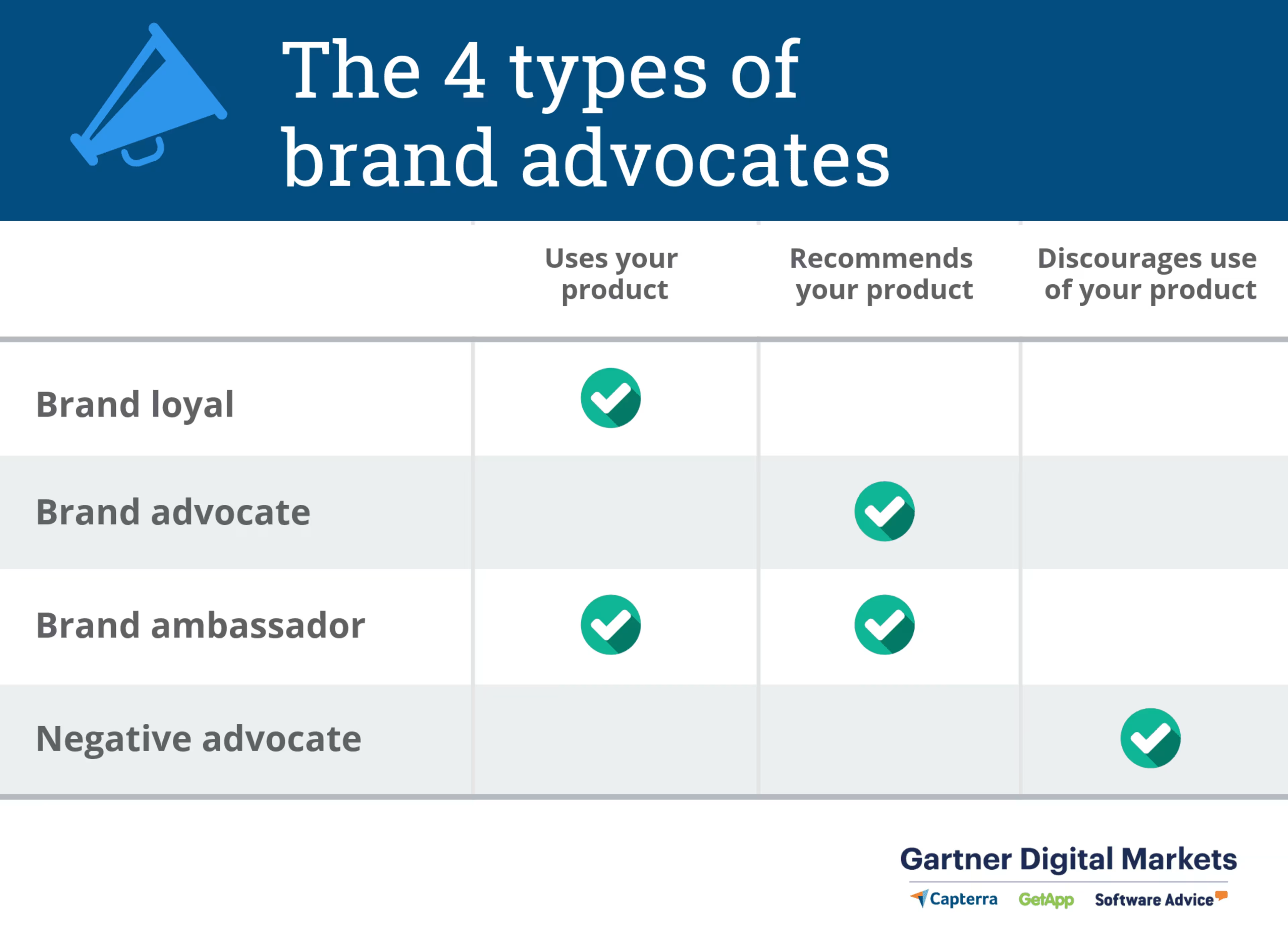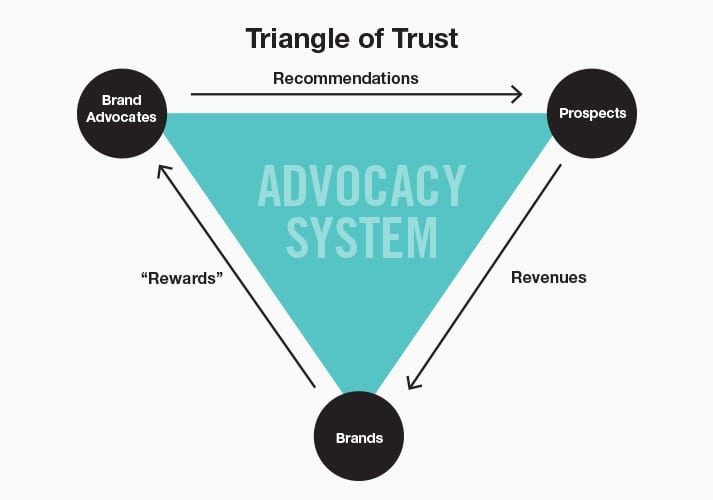While working a Tony Robbins speaking event in my youth, I noticed that a lot of the people selling tickets to more workshops and classes all wore shirts that read “Volunteer" in glittering gold on the back.
I asked one of them why she was volunteering when she could be making off like the minimum-wage bandit standing before her. Her response? She was such a fan of the speaking series that she volunteered to help out and sell tickets whenever it was in the area.
Robbins had created a culture of devoted fans who helped market his product for free. He had built a brand advocacy program, a cost-effective marketing strategy that only cost him a catering spread of ham sandwiches and a bulk order of glittery t-shirts.

Why your next marketing move should be building a brand advocacy program
Brand advocacy programs aren't just for the motivational orator. They can be vital to the success of businesses, especially those with limited finances.
Most small to midsize businesses (SMBs) lack the resources to either pay for chatbots or to employ a large client success team. An absence of either can result in lost leads and lost sales.
The cost-effective alternative to chatbots and client success teams? Brand advocacy programs, which are easy to build and can provide a baseline of customer support without adding to an SMB's bottom line.
So, if you're looking to keep your overhead minimal while still generating a stronger following among clients and leads, read on to learn what brand advocacy programs are, how they work, and how they can help you.
The 4 types of brand advocate
Put simply: A brand advocate is someone who loves your product so much that they act as a public voice in favor of your company.
In this article, we'll focus on four types of customer-based advocates:

Loyal consumers are individuals who will buy anything you sell because they like your company so much. The catch: They might not advocate for you publicly.
Brand advocates like your company and your products, so they'll talk you up to anyone who will listen. The catch: They might not actually use your products.
Brand ambassadors are the holy grail of brand advocacy. They use your products and like them so much that they'll recommend your company to friends, loved ones, and their pets.
Negative advocates don't just dislike your product, but they actively push people to avoid using it. Sometimes, your brand ambassadors and advocates can act as negative advocates for your competitors.
All four advocate types are powerful allies in helping your company reach its goals.
How brand advocacy can benefit your company, regardless of goals
Your company's goals are specific and prone to change based on any number of factors. Brand advocacy programs, however, are a universal solution to helping you reach those goals.
Let's take a look at five common business goals and see how brand advocacy programs can help:
Goal 1: Increase visibility
Brand ambassadors usually operate on social media, where they're twice as likely to share information about your company than non-advocates.
In fact, according to digital marketing service Marketing Charts, a brand ambassador will reach an average of 150 people every time they discuss your company. If you have five advocates, that's 650 new people reading about your products.
You can't buy that type of publicity, which brings us to:
Goal 2: Maintain a positive ROI
Brand advocacy programs are low cost. They garner a lot of attention for your company and its products through channels that you don't have to spend money on.
Outside of incentivizing your ambassadors (more on this in a bit) and paying for advocacy software to help monitor your program's success, there's almost no overhead.
Goal 3: Generate leads
According to a 2018 Gartner survey, 29% of SMBs rely on social media as one of their first sources of information on software purchases.*
This means that if your brand advocates are active, the increased visibility and positive buzz they generate will give you a head start on bringing more than a quarter of all software buyers into your sales funnel.
Goal 4: Increase productivity
With brand advocates doing a large chunk of public outreach, generating organic search results, and creating demand, your marketing team can dedicate more time to innovative projects and reaching more channels.
Since 80% of marketers feel overworked, this relief to their schedules can be a major asset.
Goal 5: Nurture clients
By transforming clients into brand advocates, they will feel more like your partners. They'll feel as though they're a part of your process and a valued member of your community.
This is a great way to collect feedback, get to know your client base even better, and make them feel valued.
The key ingredients to creating your own brand advocacy program
To make sure your brand advocacy program is effective, you need to follow a few broad guidelines.
Establish your program KPIs
Before anything else, develop some tangible key performance indicators (KPIs). These can be something as simple as “increase social media following," which is both easily measured and clearly linked to your advocacy program.
Be sure that your KPIs are directly tied to brand advocacy. You don't want to set yourself, your team, or your program up for failure.
Here's an example. A bad KPI in this situation would be “increase sales." There are a number of factors that go into increasing sales besides social media presence, and attributing it all to your brand advocacy program as opposed to the many contributing factors is both reductive and a harmful way of thinking for your team, and your company.
Identify your target audience
Next, you need to figure out who exactly your target audience is with this endeavor. What social media channels do they frequent? Who are they listening to?
Answering both of these questions is incredibly important when it comes to finding advocates, as you want to throw your weight behind vocal advocates in the most effective channels and demographics for your product.
Select the top candidates for brand advocacy
But how do you find these advocates?
You have to monitor social media activity and mentions to find people who are either brand advocates or brand loyal. You can do this with customer relationship management software or social listening tools.
Make sure these potential ambassadors are professional, clear communicators, and already have a large social media following.
Once you've vetted them, start your new relationship by following them on social media and engaging with their content.
Transform advocates and brand loyal consumers into ambassadors
Brand loyal consumers are great resources on their own, but can do even more work for your marketing as brand ambassadors.
If your company begins supporting a cause or charitable organization, it gives them social incentives to align themselves with your values and publicly support your company.
People naturally want to share things online; it gives them a sense of fulfillment and self-definition, and improves their perception of their relationships.
In order to convert brand advocates into brand ambassadors, you need to understand their pain points. Figure out why they like your product enough to discuss it but not enough to use it themselves.
By bringing them into the conversation, you can nurture that lead and increase your chance at converting them.
When you work through this process, you can build a successful brand advocacy program that serves your needs and the needs of your clients.
Incentivize your ambassadors
Start rewarding people for contributing to conversations. This can take many forms, ranging from sending them company swag or offering discounts on new products to simply giving them a public shoutout on your own social media profiles.
Done well, these incentives eventually lead to this:

The mutually beneficial nature of brand advocacy programs (Source)
2 other types of brand advocates
Beyond the world of social media, there are two other ways that you, as an SMB, can create brand ambassadors.
THE FIRST IS THROUGH EMPLOYEE ADVOCATES: Employee advocacy is when your own workers are so enamored with your company and its products that they become outspoken voices in your favor.
These employees can be an invaluable resource; according to global communications marketing firm Edelman, 52% of consumers see employees as credible sources of information about a business.
THE SECOND IS UNIQUE TO B2B BRAND AMBASSADORS: If you sell your product to a particular company, and one of their employees moves to another company, they can become brand advocates for you at that particular organization.
These are harder to attract and recruit, so the best hope you have of accessing them is through aggressive client nurturing. That way, if they do leave their current place of employment, they move on with a strong impression of your product.
Regardless of where you procure your brand ambassadors, though, it's important to keep them involved, keep them incentivized, and keep them engaged.
With those caveats in mind, you have a low-maintenance and low-cost way to generate excitement and information about your company and your product.
Thinking about hiring a branding agency to help your business set up a branding strategy? Browse our list of branding agencies and learn more about their features in our hiring guide.
Narrow your search with our list of companies in the following areas: